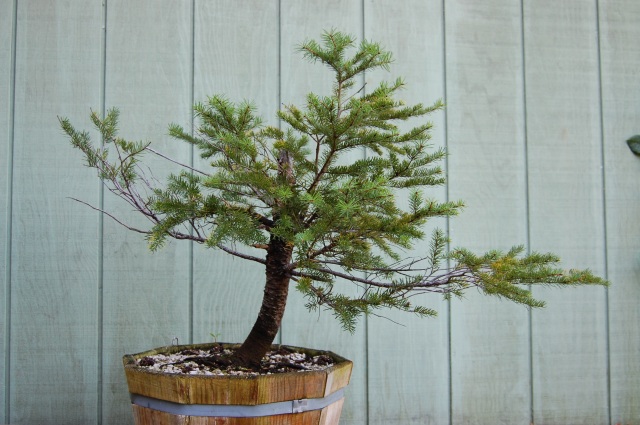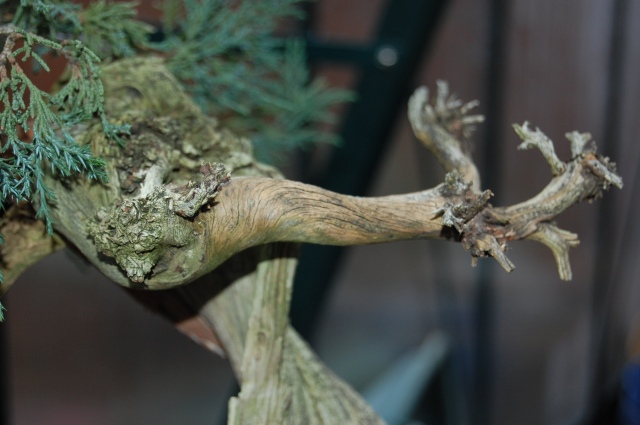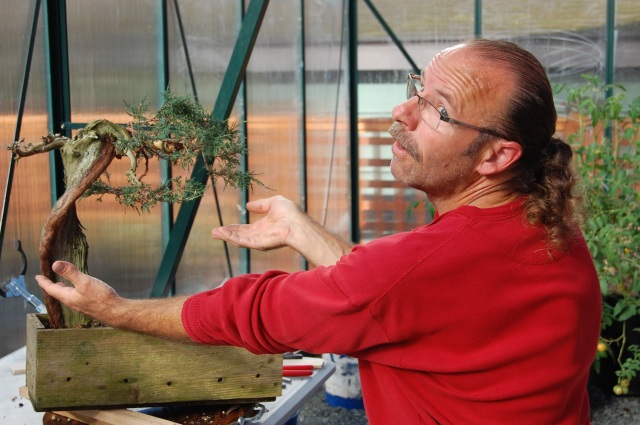The subject of today’s post, ‘A large Lodgepole Pine’ came from the same source as the tree from a post I did here a couple of weeks back titled ‘Indian Summer’. It was collected in the southern Oregon Cascade mountains, near the Crater Lake area, I was told. The tree was balled and burlapped and heeled into a growing field for an undisclosed period of time. It was a strapping specimen when I first spied it and the trunk was barely visible there was so much dense foliage. The owner of this tree and many others is named Sergio and he and his helper will dig the tree out for you. When I decided to buy it, the digging began and it revealed a whopping rootball contained in fairly well preserved burlap. Sergio picked it up and carried it to the car…it looked so easy. When I got it home, it was all that two of us could do to wrestle this monster out of the car and into the garden! It was in a very heavy clay-type soil I immediately set out to get rid of. It’s important to note right here that the date was early March and the opportune time to repot this species of pine. I had a urethane foam replica of a wooden whiskey barrel I purchased on close-out from a Super K-Mart down the road. It’s 21″ in diameter and nice and deep. The challenge was reducing the rootball enough to fit comfortably in the pot. I used 100% pumice as I do with all my collected trees or trees I put in grow boxes or barrels, in this case 😉 The buds were beginning to swell when I acquired the tree and they never skipped a beat in spite of removing a large percent of the heavy clay field soil the tree was in. Once I recognized the vigor of the tree, the next task was branch selection and pruning. I wish I had an earlier photo of just how thick and full this tree was at first, but I don’t. The first picture up was taken last Sunday before serious styling began and after a year of constant pruning and trying to see the direction I should take the tree:
Sorry for the terrible background but I wanted to save my energy to style this thing not move it around to get the perfect photo. Another shot closer in:
Somebody move that stuff out of the way please! I placed a vine maple I collected in with the pine and the roots had escaped the bottom of the pot and had become quite well established over the summer. I’m thinking cascade style and the Hagedorn pot to the right of it was one I’m considering for the tree…but I digress. Getting back to the subject of this post, the diameter of the tree at soil line is 4″. Those thick branches near the top are over 1″ in diameter and I tried bringing them down with some pretty substantial zip-ties you can see in this photo. I put them on sometime this summer to get an idea of how I might use those thick branches so far up the tree. My initial plan was to use everything I could as I had removed most of the branches from the tree at this point. But as I started looking closer at the tree I began wondering if I couldn’t take a little more off…
Whoa! what happened? Sorry again for the huge jump in progress here, there wasn’t anyone around to take the in-between shots. I see the junk in the foreground has been cleared away though 😉 This shot was taken late in the afternoon after most of the major branches had been wired. I can tell you that I didn’t cut all those thick branches off, instead I used some of the ones whose diameter was appropriate for being that high up in the tree; remember we always want to have our thickest branches lower down on the tree if we can. The next morning saw a rare phenomenon for Portland in November–sunshine! I hastily grabbed my camera and took a few shots of the tree while I had this opportunity:
And a little closer:
One possibility for the front:
A little to the right, please:
It’s possible to see from this view what I did with the branches which were very long and had only a tuft or so of foliage at the tip. This view also shows some of the movement the trunk has in the upper area. I am on the lookout for a pot for the tree now and if all goes well I will pot it up in March of 2014. Again as before, I had a little fun with one of my collected accent plants that had been in a 4″ pot in the greenhouse for a couple of years. It’s a clump of beargrass that I separated from a tree I collected years ago. I recently put it in a pot that was made by my friend Mardella Brock of Bozeman, Montana. I saw it unglazed in a scrap pile that was destined to be tossed and asked her to glaze it and fire it even though it was broken. She thought I was crazy but it turned out to be quite suitable for the purpose:
A close-up of the ‘trunk’ and ‘nebari’ 😉 :
I believe I see the sun poking out from the clouds…See ya!





























































